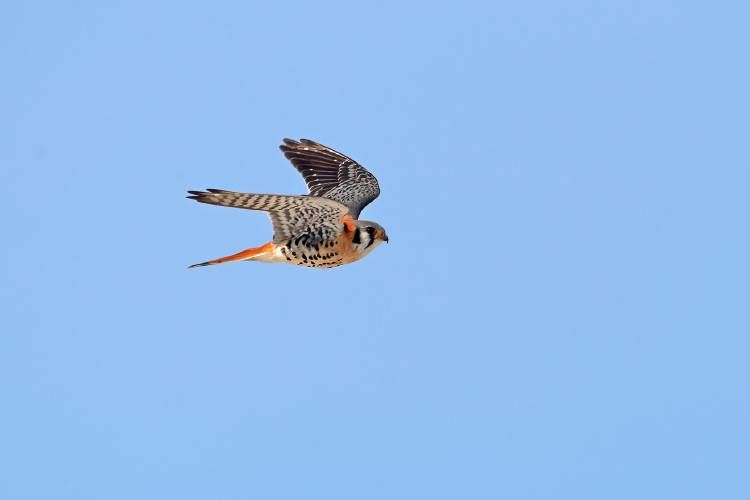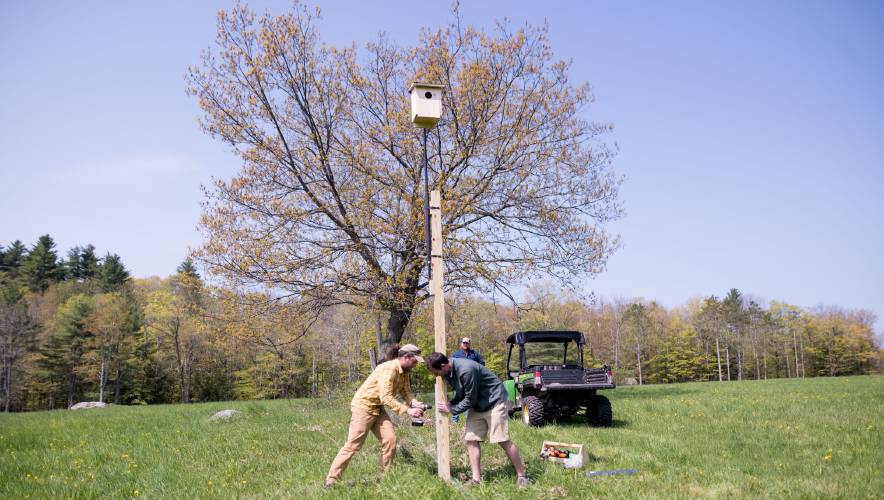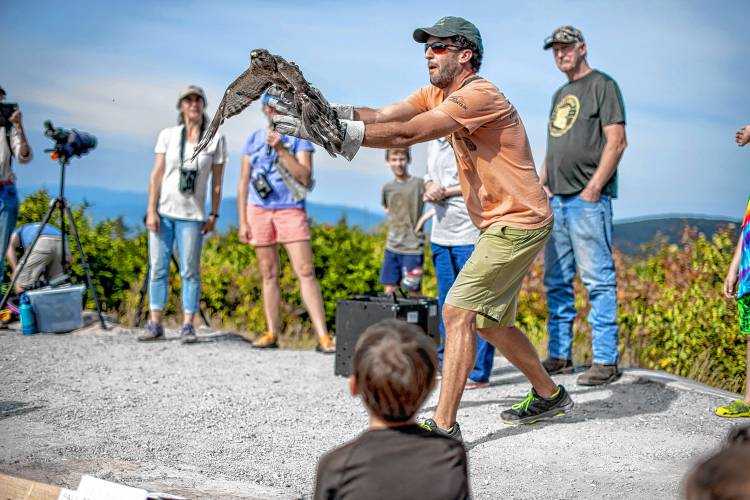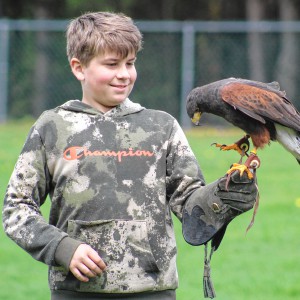BACKYARD NATURALIST: Phil Brown – Kestrel conservation expands in the Contoocook Valley
|
Published: 04-26-2024 8:33 AM
Modified: 04-26-2024 9:50 AM |
Nest boxes are popping up in large fields across the Contoocook Valley (and beyond).
From Hillsborough to Harrisville and Walpole to Wilton, these structures stand tall, perched atop a wooden post and mounted on a steel pole that extends the boxes even higher, a good 13 feet over the grassland habitat below.
Often, they are placed out in the open, but some are tucked into treelines. Though these palatial cavities often garner the interest of the smaller tree swallow and Eastern bluebird, the nest boxes described here are intended for a larger and less-common target species – the American kestrel, the smallest and most-colorful falcon in North America, a species declining at an alarming rate in the Northeast.
For a second straight year, the Harris Center for Conservation Education is leading a regional effort to expand a nest box program to conserve the kestrel, a listed “species of greatest conversation need” in New Hampshire. Working closely with private and public landowners, Harris Center staff place nest boxes in high-priority open field settings where natural cavities are often lacking.
Once common in the region, the kestrel has seen population drops across its entire range, but especially in the Northeast, where a 93% population loss has been tracked since the 1960s by the Breeding Bird Survey, a project of the U.S. Geological Survey. Here, large expanses of agricultural fields have been converted to both forests and houses.
While somewhat new to the Monadnock region, this project adds to continent-wide conservation work focused on the species. Though a relatively simple action in practice, it represents the greatest hope of maintaining kestrels in these landscapes.
The goal of such projects is to build back the population of kestrels eventually. However, researchers have concerns about continuing population slides that may be related to unmitigated factors such as the loss of insects, a major source of the kestrel’s diet, and predation by larger raptors such as the Cooper’s hawk, as cited in the State Wildlife Action Plan. The widespread use of rodenticides, a newer threat, may also kill them.
A migratory species in the Northeast, the kestrel ventures well to the south of New Hampshire’s border during the cold, snowy winter months. Its diet consists largely of small mammals like voles and mice, but this falcon also preys upon numerous larger insects, snakes and small songbirds. Well-adapted hunters, the long-winged kestrel can hunt both from a perched position (utility poles and lines serve equally well as isolated dead trees) as well as from flight.
Article continues after...
Yesterday's Most Read Articles
It employs a unique “hovering’ tactic” – flapping from a stationary point in the air – which allows the kestrel to hone in on moving prey with a faster reaction time, allowing it to drop down on its prey quickly. The kestrel famously can detect vole trails with vision sensitive to ultraviolet light, lighting up urine trail pathways these capable predators.
A close look at a kestrel will reveal bright coloration. Males don a blue cap and wings, a rusty red back and tail, and a cream-colored chest. Females are brownish-red overall and are more streaked. Both sexes have black facial markings typical of falcons. Kestrels perch in the open on snags and utility wires and appear long and slender in an upright position, often bobbing their tails.
Males are vocal in early spring when they return to breeding territories. A colloquial name, the “killy bird,” comes from its high-pitched and resounding “killy-killy-killy!” given near nesting sites. By May, most kestrels in our region will be incubating between four and seven eggs, and by July, fledglings will enter the world.
This year, new boxes can be viewed along the Cranberry Meadow Trail in Peterborough, Beech Hill in Dublin, across from Distant Hill Gardens in Walpole and the Surry Lake Army Corps fields in Surry, among over a dozen other locations across the region. The Harris Center is still looking for new locations for kestrel boxes and would like your help finding suitable sites.
A great way to help is by reporting your kestrel (and other bird) sightings to ebird.org, the largest public database of bird sightings. And even if you don’t have a large-enough field to support breeding kestrels, you can help them and other raptors by being responsible stewards of nature, maintaining native habitats for wildlife and eliminating the use of rodenticides (rodent bait boxes) and pesticides.
Last summer, the Harris Center documented four successful nesting pairs, yielding 17 kestrel fledglings. This summer, the number of nest boxes will have doubled. Will kestrels respond? Only time will tell.
To learn more about this charismatic and colorful falcon and to see how you can help conserve kestrels, see the story map created by former intern and Antioch University student Will Stollsteimer at storymaps.arcgis.com/stories/8f760e37fc1648d7b40cefba7de
81734.
Phil Brown is bird conservation director at the Harris Center for Conservation Education in Hancock and can be reached at brown@harriscenter.org.




 Christopher Stultz of Antrim sentenced to 18 months for false statements
Christopher Stultz of Antrim sentenced to 18 months for false statements Veterans’ breakfast returns to South Meadow School in Peterborough
Veterans’ breakfast returns to South Meadow School in Peterborough Mondanock Falconry visits Boynton Middle School
Mondanock Falconry visits Boynton Middle School
